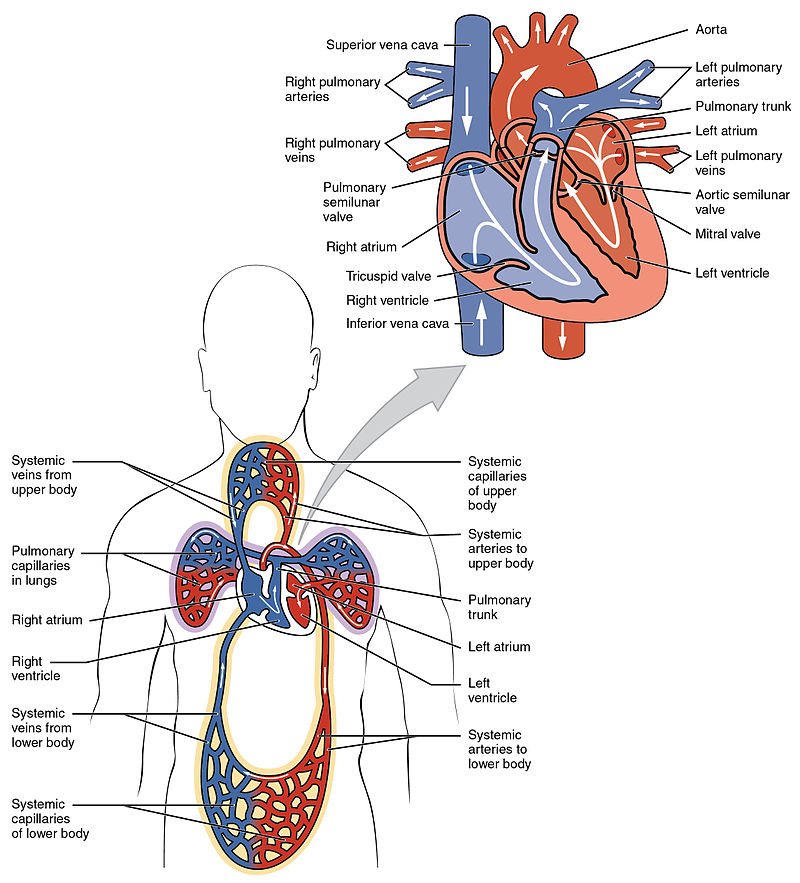Key Difference – Pulmonary Artery vs Pulmonary Vein
Before discussing the between Pulmonary Artery and Pulmonary Vein in detail, let us first briefly discuss the circulatory sysem and its function.The human circulatory systems is a closed system and mainly consists of heart; a powerful muscular pump, and various blood vessels, which transport blood throughout the body. This system responsible for delivering oxygen and other important nutrients to body’s cells and removing metabolic wastes from the cells. In addition, the circulatory system is also involved in the body’s defense system. Two blood circulation systems are found in the human body, namely; pulmonary system and systemic system. Pulmonary circulation is the circulation that occurs within the lungs and responsible for exchanging gases between the blood and alveoli of lungs. Pulmonary arteries and pulmonary veins are the main components of the pulmonary circulatory system. Systemic circulation includes all the arteries and veins found inside and outside of organs except lungs. The key difference between these two is that Pulmonary artery transports deoxygenated blood pumped from the right ventricle of the heart to lungs while Pulmonary veins delivers oxygenated blood from lungs to left atrium.

What is Pulmonary Artery?
Pulmonary artery transports deoxygenated blood pumped from the right ventricle of the heart to lungs. The semilunar valve at the beginning of the pulmonary artery prevents backflow of the blood into the heart. The pulmonary artery is the only artery to carry oxygen-poor blood other than the umbilical arteries in a fetus. This artery is short and wide (about 5 cm in length and 3 cm in diameter) and branches into two pulmonary arteries, both delivering blood to right and left lung. The blood carried through the pulmonary artery has more metabolic wastes and high concentrations of carbon dioxide, which is exchangd and expelled from the lungs.
What is Pulmonary Vein?
Pulmonary veins deliver oxygenated blood from lungs to the left atrium. It is the only vein that carry oxygenated blood to the heart. Humans have four pulmonary arteries, two from each lung. Pulmonary veins carrying blood from the right lung are called right superior and right inferior veins while the other two pulmonary veins are named as left superior and left inferior veins. Pulmonary veins branch into small veins making a network of capillaries in the alveoli, where gas exchange is taken place.
What is the difference between Pulmonary Artery and Pulmonary Vein?
Definition of Pulmonary Artery and Pulmonary Vein
Pulmonary artery: Pulmonary artery is the artery that carries deoxygenated blood pumped from right ventricle of the heart to lungs
Pulmonary veins: Pulmonary vein is the vein that carries oxygenated blood from lungs to the left atrium.
Characteristics of Pulmonary Artery and Pulmonary Vein
Nature of the Blood
Pulmonary artery: Pulmonary artery carries deoxygenated blood with more metabolic wastes and high carbon dioxide concentration
Pulmonary veins: Pulmonary vein carries oxygenated blood with more oxygen and less metabolic wastes
Anatomy
Pulmonary artery: Pulmonary artery is connected to right ventricle of the heart
Pulmonary veins: Pulmonary vein is connected to left atrium of the heart
Number
Pulmonary artery: Pulmonary vein branches into two.
Pulmonary veins: Each lung has two pulmonary veins, thus four pulmonary veins in total.
A semilunar valve is only present at the beginning of the pulmonary artery.
Image Courtesy: “2003 Dual System of Human Circulation” by OpenStax College – Anatomy & Physiology, Connexions Web site. http://cnx.org/content/col11496/1.6/, Jun 19, 2013.. Licensed under (CC BY 3.0) via Wikimedia CommonsncG1vNJzZmivp6x7pbXFn5yrnZ6YsqOx07CcnqZemLyue8OinZ%2Bdopq7pLGMm5ytr5Wau2681KWkqKaRp8ZurdGtnKuxXZa7pXnVrGSprZyivK%2Bt0bJkr52Zo3w%3D